The first time I found myself in a speedboat at night, I was going through training for the US Air Force, surrounded by guys with night vision goggles, and going about 40 knots. The second time, I was just trying to get home. Both times, I was sure I was going to die.
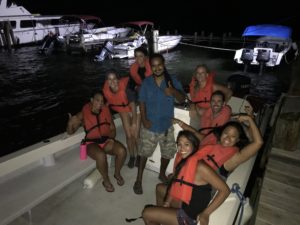
Let me back up here and say that most people who visit San Pedro, Belize, have to do so by boat. Most of them take one of several ferries to and from the mainland, and the ferries typically run from 6:30 in the morning to 5:30 in the evening — and I can tell you from personal experience that the 5:30 departure time has little to no wiggle room. I can also tell you that no amount of begging will make a ferry captain wait for you, and the remaining options are called “contingency plans” for a very good reason.
YOU BETTER BELIZE IT (and other slogans found on t-shirts)
I was on a week-long vacation with seven friends to the Caribbean nation of Belize, located on the eastern coast of Central America, just to the southeast of Mexico. We had planned the trip for months, and we were going to do everything that we could to enjoy it. The fact that it started off with passing around a bottle of Fireball (if you’ve ever drank it, then you know its chaotic capabilities) on the first ferry out was a pretty good indicator for how the rest of the week would go. But most of the real chaos comes later (we’ll get to it, I promise).
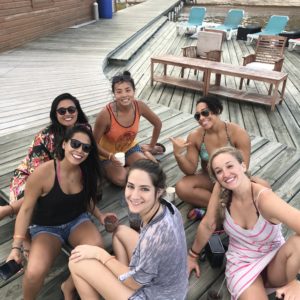
The first few days were spent enjoying the island of San Pedro: snorkeling and scuba diving off the barrier reef, driving a golf cart around the island to find the so-called “secret beach” (note: when your beach shows up on TripAdvisor, it is not secret), and hanging out dockside sharing drinks and stories. But on my last day there, we decided that we wanted a change of pace.
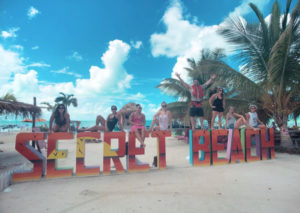
MAINTAIN A HEALTHY FEAR OF CHANGE
Our friend Casey, a mastermind with planning and coordination, found us a local contact, Marvin, who was willing to act as a tour guide for us. Marvin would be renting a van that would fit us all, then hauling us all the way across the entire country of Belize — and back. We woke up early enough to catch the 0630 ferry from San Pedro to the mainland, met Marvin, and hatched a plan.
The plan was to drive the roughly 81 miles from the east coast of Belize to the west, coming right up on the border to Guatemala. There, we would see Xunantunich, a nearly 1500-year-old Mayan archaeological site, and hopefully check out some local wildlife. After this we would travel 26 miles southeast to Big Rock Falls, a gorgeous waterfall nestled in the Mountain Pine Ridge forest reserve in the Cayo district. Finally, we would drive back and catch the last ferry to San Pedro at 5:30pm. And if you paid attention in the opening paragraphs, you can probably guess which of those things we did not, in fact, do.
ON THE ROAD TO RUIN(S)
The drive across the country of Belize — which is roughly as wide across as New Jersey — could best be described as “hazardous.” Not only were maybe half of the roads even paved, but the concept of Death by Crashing into Things seems to be an entirely foreign concept to Belizeans, who regularly laugh in the face of the Grim Reaper as they scream towards him in their Toyota Tacomas. When there were solid yellow lines on the road (known to most humans as “no passing lines”), Marvin seemed to take them as a challenge, ignoring the choruses of “We‘re going to die!” and speeding into oncoming traffic in order to pass the slower, saner cars to our right. But, after about a two hour drive, we had arrived safely despite Marvin’s best efforts to sacrifice us to the ancient Mayan gods.
In order to get to the actual site of the ruins, though, we had to cross a river that was maybe 20 feet across — and since the ancient Mayans never got a chance to lease a Ford, they didn’t prepare too well for the possibility of one being driven across the river to their buildings. So we had to cross the bridge on a hand-cranked ferry that used a cable to haul the floating, barge-like platform back and forth across the river.
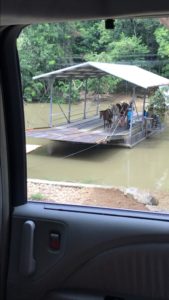
Once across, we drove the short distance to the tour office to park. We stepped out of the stuffy van and into the muggy Belizean air where we were greeted by the sounds and smells of the jungle — neither disappointed us. A family of monkeys was swinging their way through the trees above us as we walked to the ruins, and the overcast sky was actually clearing up enough for us to get a good look at the surrounding countryside. On top of one of the tallest Mayan towers, you could see all the way into neighboring Guatemala, with its tiny farmhouses looking like dots among the deep green of the jungle in front of us. We saw what we could, took a multitude of pictures for the ‘gram, and walked back to the van to head to our next stop.
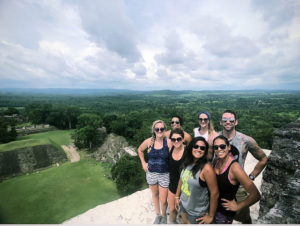
DON’T GO CHASIN WATERFALLS — OR FERRIES
(Neither will wait for you)
Even though pavement has been around since 1870, the proud Caribbean nation of Belize chose instead to utilize its vast stores of dirt to make its roads, preserving its “natural” look and making paths that bump harder than a Kendrick Lamar track. I had previously thought that Belizean drivers’ disregard for safety and yellow lines was the worst part of driving; I was disappointed to find out that I would soon be disappointed. The same principles that make it possible to get air sick or seasick — rapid, jerking motion and the fact that our inner ears hate us — apply to cars as well, and it turns out that 45 minutes of driving on bumpy dirt roads is in fact the worst part of driving.
But, mercifully, our suffering would soon come to an end as we pulled up to the resort attached to Big Rock Falls. And, while the name could use some work, the view was as close to perfect as I can imagine. It was roughly a five minute hike to the river where we shed our shoes and our dignity, jumping into the slow-moving waters at the base of the 150-foot waterfall.
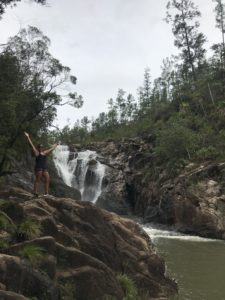
You would think we would have paid attention when Marvin said things like “We can’t stay long”, “we should hurry”, and “don’t pee there,” but we were way too busy having fun to actually heed good advice.
A BUMP IN THE ROAD
After Marvin somehow managed to herd the legally-recognized-as-adult children from the waterfall and back into the van, the specter of doubt peeked out its head from behind the van’s clock as we thought about how long it would take us to get back. We knew that the last ferry left at 5:30pm. We knew that traveling by boat was one of the only ways to get to the island where we were staying (but our grasp of the concept of an island is apparently very loose). And, arguably most important to our motives and this story, we knew that I was catching my flight back to America in the morning — and that my passport and luggage were both back in San Pedro. But clearly none of these things seemed to mean anything to us as we flew over the bumpiest dirt roads in existence.
Yet as we got closer and closer to Belize City where the ferry left from, and the clock kept ticking closer and closer to 5:30, we started to realize that we might have a problem on our hands.
PLAN B (AND THEN C. AND THEN D)
As time ticked on and the road did not magically get shorter or easier to drive, we started to accept the fact that we were going to be late. We thought about what we could. On the back of our ferry tickets was a number.
“Why don’t we give it a call?” our friend Jenny suggested. It was the number to the Belize city location and, we assumed, to the ferry captain. [Editor’s note: “the Ferry Captain” sounds like a character in a C.S. Lewis story].
Marvin agreed that this was a good idea. Casey, with her sweet southern charm, was elected to be the spokesperson for the group.
“Yes, hello,” Casey said in her South Carolina twang. “We’re on our way back and we realized we’re going to be a little late.”
I leaned over to whisper helpful tips. “Throw in a ‘y’all’,” I suggested. Casey declined.
“How late?” asked the voice on the other end. Casey relayed the question to Marvin, who said that we would be getting there at 5:45. We may have slightly massaged this number, but the ferry people didn’t need to know that.
“They said they can only hold it until 5:37,” Casey said to us after she hung up. We looked at the clock, which read 5:25, and knew that we were at least 20 minutes away — maybe more. [Editor’s note: it was more]
Right then, we started to brainstorm ideas. We called the hostel and found out that there was a small airline that did flights to and from the island for roughly the same cost — but instead of an hour and a half ferry ride, it would be a quick 15 minutes through the air. We asked the front desk to contact the airline and reserve seats for us. As 5:35 came and went with easily 10 city miles between us and the ferry, we knew that plan A (the ferry) was now off the table. We redirected to the airport knowing that the last flight of the night left at 6:00pm. The airline said that we would need to be there at least 10 minutes early. We pulled up at exactly 5:50 in the dark and drizzling Belizean evening.
Oh and speaking of “ten minutes early,” that is exactly when the last flight of the day left, citing “weather and darkness” as two factors in its early departure. As we stood there listening to the props starting to spin on the currently-leaving plane, we could do nothing as our plan B fell off the table right where plan A had collapsed minutes earlier. We were stuck.
Now I am not a very strong swimmer so I doubted my ability to swim the 36 miles in the dark Atlantic to San Pedro, but that was quickly looking like my best option. I absolutely had to retrieve my passport in order to make my flight in the morning.
That’s when Marvin, after making a few calls, announced to the group, “I think I found us a boat.”
Somehow Marvin, using his knowledge and contacts in the area, had managed to get us in touch with a boat captain who agreed, for about $400US, to ferry us to San Pedro despite it being dark and rainy. And, knowing that I had no real choice, we agreed that we would make the trek home that night.
CAPTAIN PHILLIP
We were pleasantly surprised when we saw the boat that would be taking us across the dark ocean. It had all the things that a boat should have: a canopy to keep the rain out; running lights to, I don’t know, see things in the dark; and some handrails that went around the perimeter that looked to be useful for holding onto while speeding across the surface of the choppy Caribbean.
“No, no,” we heard the captain say. “Behind that one.”
Ah. Of course. The boat that WE would be traveling in had none of those boat-related things that I mentioned above. It was small, maybe ten feet long, white, and only vaguely boat-like. It did have a motor, though, so I guess that qualifies it to be categorized as a “boat” in the same way that a tambourine player can be said to be “in a band.”
“We’re going to be taking THAT?” our friend Rikki asked, clearly also in doubt of our boat’s boat-ness.
“Yes,” our captain said, who introduced himself as Phillip. He was a thin, dark-skinned man who told us he’d been doing this for about ten years. I wasn’t sure how many times he had ferried over a boat full of time-illiterate Americans terrible at catching ferries, but I didn’t ask. He looked capable of handing himself in a nautical setting.
After giving us our safety brief telling us all to put on our lifejackets, Phillip did exactly zero of that and hopped on to cast away. The only reason I mention his lack of lifejacket is because he did something that, like I said at the beginning, convinced me that I was going to die.
OUT OF THE DARKNESS AND INTO…MORE DARKNESS
I admit that I have slightly exaggerated the lack of light on our boat, but I assure you that it isn’t by much. What little I know about maritime law I learned from watching Arrested Development, and I knew that we had to have a green light and red light on either side to tell any boats coming toward us that they were in fact coming toward us. (Maritime law is rather foggy on the necessity of any other source of light that could be used, for example, to see in an absolutely pitch black abyss of sharks and danger). So, when the required red and green lights suddenly stopped working, captain Phillip looked at me and said “Point us forward,” and left me holding the wheel. He then proceed to — get this — climb onto the front of the boat with no lifejacket around him or rope securing him to try and fix the light. While we were still moving. Italics added because I am screaming these words in my head. I hope that they come across as absolutely insane and death-ignorant as I now realize that all Belizeans exactly are.
The rest of us on the boat who still had a healthy fear of dying looked at each other and pictured all the very probable ways that we would be meeting our end. Most of us expected a giant shark to leap out of the water to eat Phillip; some of us (me included) were positive that he was going to be tossed overboard as the boat was rocked by the not-at-all calm collection of the largest body of water on the planet (i.e. the entire ocean); others figured that, with the way our day had gone, God would probably be smiting him for trying to help us.
When Phillip finished fixing the light, we all exhaled. He wasn’t dead. He hadn’t been tossed, eaten, or smitten! Today was our lucky day.
Then, the light went out again.
Collective holding of breath. Surely death is coming for us now.
Captain Phillip returned, and we all breathed out. Not today, death. Not today!
Then it HAPPENED AGAIN. I am not even joking. I think it may have happened a fourth time too, but by then I was searching for a signal on my phone so I could update my will.
But, as you no doubt may have guessed by now, I did not die. In fact, none of us died. I’m still trying to figure out exactly how because, (1) speeding across the
pitch-black and dangerously choppy ocean, (2) getting sprayed in the face with water, and (3) being constantly threatened with losing our Phillip to a shark with incredible knowledge of boat lighting, seem like really, really dangerous things. Yet we somehow managed to not let any of those things murder us.
We would not greet the Mayan gods that night.
After an hour or so, we finally found the dock in San Pedro, said our goodbyes to Phillip, and started up the golf carts that we had rented to get home. Everything was going to be alright.
LAST LAUGH
Everything was not alright.
Ok so this last part isn’t actually that bad, but we all thought it was hilarious after the adventure we just had. What we did not know when we had parked our golf carts that morning was that the exact street that we were on would shut down after about 7pm. It was nearly 8 by now. So, when we drove out of the parking lot, we found that we could only go about 20 feet before being met with a barricade. We were stuck — again.
Lucky for us, we had already proven that we were resourceful. We looked at the golf carts with their thick rubber tires, and we looked at the small curbs that separated our parking lot from a clear shot to the beach — and, by proxy, to freedom. We looked at each other and nodded with determination. The curbs, much like the yellow no-passing lines in Belize, were immaterial. While it did take some assistance from us (we had to lift up the front then back of the carts to get them over), we were able to get both golf carts over the curbs and on the way to freedom.
NOW everything was going to be alright. The only tough choice facing us after that would be showers or shots. Most opted for shots.
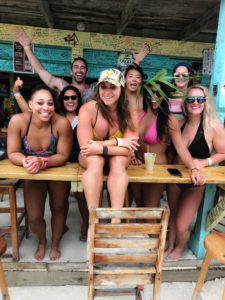
All in all, though, I am amazed at my continued ability to not be dead, despite being obviously plotted against year after year. I owe a lot of thanks to my friends — some of whom were mentioned in this very post — as well as some definite blame. But, despite their best efforts, I continue to be alive to chronicle the bizarre and terrifying experiences to help you pass the time while you’re in the bathroom.
But, if you take anything away from this story, know this: if a Belizean ever offers to transport you anywhere, make sure your affairs are in order before you leave, because it’s going to be a bumpy ride.
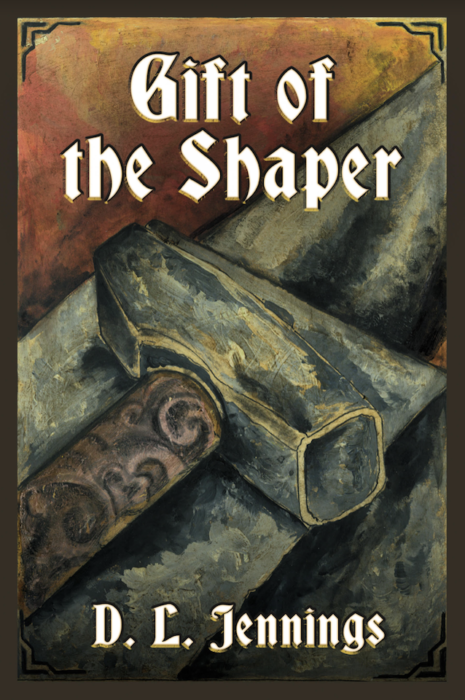
Kenneth Webster
October 9, 2018 - 9:02 am ·Great article! DL Jennings is the US Military’s best independent author.